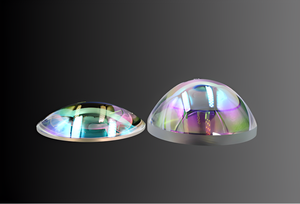
Types of Aspheric Lens
An aspheric lens may have any of a number of geometries. Most aspheric lenses are rotationally symmetric but have a more complex front surface. Unlike a spherical lens, the curvature changes with the distance from the optical axis. Another way of putting this would be to say that the radius of curvature varies radially from the center of the lens.
Typically, the further from the optic axis, the weaker the curvature. A lens that does not have these symmetries is typically called a free-form optic.
Aspheric lenses are defined by their surface profile (sag of the surface parallel to the optical axis) or by means of orthogonal coefficients Qbfs and Qcon. Qbfs quantifies the RMS slope departure of your aspheric lens from a best fit sphere, and Qcon quantifies the sag departure from a base conic.
Aspheric lenses are optical lenses with non-spherical surfaces, meaning they have a changing curvature across the lens rather than a constant curvature, as seen in spherical lenses. Because aspheric lenses contain controlled variations in curvature across the surface of the lens, they correct for the optical aberrations that occur with spherical lenses. Removing these aberrations has several important benefits:
Improved image quality: The controlled curvature of an aspheric lens reduces the number of aberrations and improves overall image fidelity and clarity.
More Compact and Lightweight Design: The ability to control the lens surface curvature of aspheric lenses enables the design of thinner and flatter lenses, reducing the overall sizes and weights of optical systems. Furthermore, designs with traditional spherical lenses often require a greater number of lenses in order to compensate for the optical aberrations and improve image quality. Because aspheric lenses have fewer aberrations, designs utilizing these lenses can achieve high levels of image quality with fewer lenses. The compactness and weight reduction afforded by aspheric lenses are particularly advantageous in portable devices like cameras where size and weight constraints are critical.
Increased Design Flexibility: Aspheric lenses have curvatures which can be adjusted as needed. The increased flexibility in designing the lens shape, curvature, and performance parameters enables optical engineers to optimize the performance of their systems. This design flexibility leads to more efficient and cost-effective optical systems with improved performance and reduced complexity.
By integrating controlled variations in curvature, optical engineers can utilize aspheric lenses to improve systems’ image qualities, create more compact and lightweight designs, and increase design flexibility.
Aspheric Manufacturing Capabilities
| Diameter |
5 – 200mm |
| Diameter Tolerance |
+0/-0.100mm – +0/-0.010mm |
| Asphere Figure Error (P – V) |
3μm – smaller than 0.06μm |
| Vertex Radius (Asphere) |
±0.5% – ±0.05% |
| Sag |
25mm max |
| Typical Slope Error |
1μm – 0.15μm per 1mm window |
| Centering (Beam Deviation) |
3 arcmin – 0.5 arcmin |
| Center Thickness Tolerance |
±0.100mm – ±0.010mm |
| Surface Quality (Scratch Dig) |
80-50, 40-20,10-5 |
| Aspheric Surface Metrology |
Profilometry (2D & 3D) & Interferometry |
Related Articles:
Case Study: Aspherized Achromatic Lenses for Detecting the Human Retina
Case Study: Double Convex Lens for Indirect Ophthalmoscopes
Case Study: Triplet Apochromat Lens used in VR headset
Case Study: Two-Aspheric Cemented Lenses for Enhanced Image Clarity in Ophthalmic Examinations
Case Study: Under Water Double-Convex Aspheric Lens











